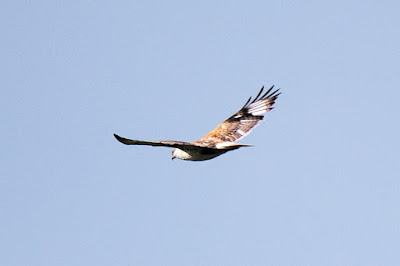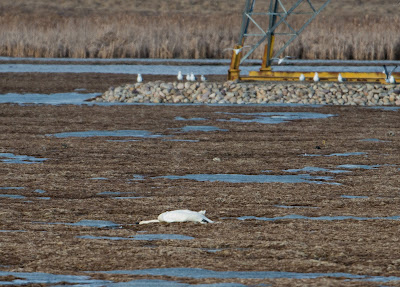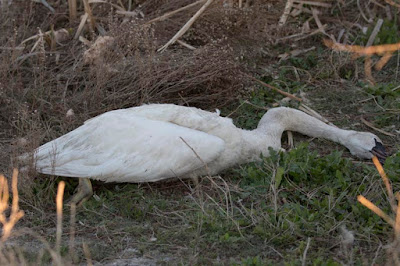In the coming weeks we will almost certainly see the Saskatchewan Government approve Algonquin Power Company's wind project four and a half kilometres north of Chaplin Lake.
That setback distance is the minimum required from a major wetland like Chaplin Lake, and we will perhaps in years to come learn how the shorebirds and other waterbirds who use the wetlands in the area are being affected by the installation of wind turbines.
, the decision to site 24 turbines on native prairie is the biggest single threat posed by this wind energy development.
Those hills of native grassland support an array of wild animals whose tenuous efforts to breed and rear viable young will be hurt by the introduction of massive vertical structures in their home ranges.
Instead of unbroken native range and open skies above, the landscape will be dominated by a network of 24 wind generators filling the sky. And the sky matters. For hawks and aerial-displaying birds like the pipit and long-billed curlew, open sky with no vertical structures
is habitat. Each turbine site will have a gravel pad footprint where the native cover is removed. As well there will be an electrical substation, a web of new electrical collector lines, and new roads into each site and connecting one to the other.
Click on this link to see a short (and windy!) video of the native grass-covered hills that will soon fill the air with turbines instead of hawks and pipits.
So, how many hawks, curlews, pipits and other vulnerable birds breed in this landscape that will be damaged by Algonquiin's wind project? Stantec Consulting Ltd., the "environmental consultants" who conducted the environmental impact research work and wrote the Environmental Impact Statement for the proponent, did some breeding bird survey and amphibian surveys from 2012 onward.
Here is a map from the
EIS document--but it merely shows a few of their records:
More significantly, here is a table from the Wildlife Technical Review,
Appendix d4 of the EIS. It shows that their field survey's in 2014 turned up
672 individuals of 15 different vertebrate "Species of Conservation Concern," including Species at Risk.
672 creatures, many of whom will not be able to co-exist with the linear and vertical structures soon to come to their neighbourhood.
One odd thing about this list is the low number for Ferruginous Hawk. Local naturalists will testify that this is an important area for both Swainson's and Ferruginous Hawks.
Last Saturday, I joined a team of four other birders to do a quick survey of hawks and other birds currently using the native grassland slated for wind development north of Chaplin.
It was an informal effort and we spent less than two hours, surveying a small subset of the total grassland area to be affected.
We stayed on the few public roads that give limited access to the land, stopping at intervals to listen and watch for birds. Our hearing was limited by 70 kilometre per hour winds, which also would have suppressed bird song. Nonetheless, we heard Sprague's Pipits at three stops, and saw a pair of Lark Buntings. Along one road we found a small group of Sharp-tailed Grouse. But it was the large hawks that dominated the landscape.
Swainson's and Ferruginous hawks seemed to be on every horizon. We counted eight Swainson's, all recently arrived from their winter in Argentina, and we saw five Ferruginous--a very high number especially with our limited access to the property.
Here are two shots of Ferruginous Hawks, taken by Brian Sterneberg on Saturday morning.
Stantec had this to say in the EIS about birds and bats they recorded in native grassland:
"During bird surveys,
five sharp-tailed grouse lek were recorded and the LAA ["local assessment area"] was found to be used during nocturnal
shorebird movement. Breeding birds observed include Baird’s sparrow, bobolink, chestnut-collared
longspur, sharp-tailed grouse, Sprague’s pipit, and barn swallow. Bat species were also
identified in the LAA including: eastern red, hoary, long-eared, silver-haired, western small footed
bats, little brown myotis and big brown bat."
That is a lot of species depending on the habitat, and yet Stantec's very next sentence states, without any substantial rationale, that the project's "residual environmental effects" on these species "were predicted to be not significant." Huh?
The Ferruginous Hawk and Sprague's Pipit have already lost most of their native grassland habitat on the northern Great Plains, and have demonstrated quite effectively that they disappear from an area when the habitat is significantly altered by agriculture and other kinds of industrial activity.
The hawks we saw on Saturday were flying over the hills; the pipits were also high up in the air. They were not on fenceposts or foraging at the side of the road. Pipits don't do that. These tiny songbirds were aloft, a couple hundred feet above us, in courtship flightsong, marking the boundaries of their territories. For a pipit, a bird known to remain at this height for an hour or more at a time, the air is a significant portion of its home range.
Ferruginous hawks use the space above native prairie to hover as they hunt for their prey, ground squirrels. The first three hundred feet of space above the prairie is almost as vital to a pipit or a Ferruginous hawk as the grass below. Once this aerial habitat is overtaken by dozens of three-hundred foot high turbines with one-hundred foot long blades slicing through the air, these birds so accustomed to the sky and grass dynamic of prairie will lose their breeding grounds. We can do all the mitigation and monitoring in the world after the destruction, but it will do nothing to help them to remain and breed successfully.
The proponent will talk about remaining a certain distance from nesting sites of Species at Risk, but for a bird like the Sprague's Pipit, it is doubtful that surveyors, no matter how skilled or diligent, would find even a small percentage of their nests. Most of those 62 hectares is prime pipit habitat and there are likely pipits nesting on most quarter sections.
Where is our protection for endangered species in this country? Can someone please remind me why Canada has Species at Risk legislation? What good is it if a provincial government, acting through its Crown Corporation can sponsor the destruction of 62 hectares of habitat for officially listed species?
There are thousands of wind-swept acres a short distance north, east, and west of the islands of native grassland that SaskPower, the Saskatchewan Government, and Algonquin Power have in their sights--places that lost their pipits and Ferruginous hawks decades ago when the ancient sod was plowed.
When a government is so irrationally and without any satisfactory explanation attached to a site that is clearly a disastrous and unpopular choice, can you blame people for speculating that someone shook someone's hands on a deal we will likely never hear about?
Saskatchewan needs plenty of well-sited wind energy projects to be sure, but this is not the way to proceed. It won't do to destroy native grassland for this project and then write some toothless guideline document that will be filed on government shelves and ignored whenever it is expedient to do so.
We need to stop the government-sponsored destruction of native grassland now, while the air above the Chaplin prairie hills is still flush with song and the hovering of hawks.
Once that is done, we need something more than wishy-washy guidelines to ensure we have no more Chaplins in our future. We need to legislate and enforce strong, binding regulations on siting wind energy projects that all proponents and government agencies will have to follow.
Anything less will turn Chaplin from a cautionary tale into a dangerous precedent and more native grassland ecosystems will be degraded and destroyed by wind energy projects.

























